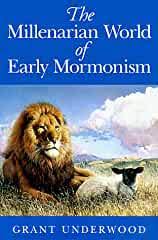Articles/Essays – Volume 28, No. 2
Unanswered Questions | Grant Underwood, The Millenarian World of Early Mormonism
Joseph Smith looked forward to a millennium when, according to the 11th Article of Faith, “Zion (the New Jerusalem) will be built upon this the American continent and Christ will reign personally.” But Smith was not the only nineteenth-century Ameri can anticipating the Second Coming. How did his beliefs compare with others? Grant Underwood asks this question. First, he examines eschatological thought through the Bible to the early nineteenth century. With this background, he places early Mormon beliefs in context. As the dust jacket boasts, it is the “first comprehensive linkage of the history of early Mormonism and millennial thought.”
Underwood then explores how Mormon millenarians used the Bible, the Book of Mormon, and Smith’s rev elations. He uses church periodicals, personal journals, and other nineteenth-century Mormon writings to show how early Latter-day Saints used the scriptures to support their millennial views. Underwood shows how the early Saints focused on the Bible. When they used the Book of Mormon, they directed their study to the restoration of Israel. This allowed them to expand the definition of Israel to include themselves.
After describing Mormon millennial thought, Underwood compares it with other groups. He argues Mor mons were moderates and not the economically deprived usually associated with those looking for a better life. He contrasts the Mormons and the Millerites. By not setting a date for the Second Coming as did William Miller, Joseph Smith did not set himself up for failure. Underwood also presents interesting contemporary re actions of the Mormons and Millerites to each other. Underwood then explains the religious conditions in England during the 1830s and 1840s and how Mormon thought, especially views of the Millennium, attracted spiritual seekers. In a short epilogue, the author then explains that while Mormons still expect a thousand years of peace, church leaders have not focused on it such 1920. “Though Latter-day Saints still talk about the end times, for many Mormons these doctrines have a detached and text bookish quality” (141).
Underwood provides an overview of Mormon millennialism. An underlying theme is that Mormons were not as radically different from other groups during the nineteenth century. Other historians present stronger cases for the opposite argument, pointing out that one of the rea sons Mormons felt so much persuasion from their neighbors was because their only true church concept differed with American pluralism.
Most of Underwood’s research is based on early Mormon publications. He uses very few other primary sources. Underwood published many of the ideas as articles; many of the chapters present the same material and have almost exactly the same titles as the articles.
The book does not provide all the answers that it could. All of the material covers from 1830 to 1846 when Joseph Smith headed the church and the short time following his death. But other than on the dust jacket, the author never describes his time frame. He also does not have a clear chronology of Mormon history. While other histories include the church’s experiences in Kirtland, Missouri, and Nauvoo, a reader without that background would be lost.
Throughout the book, Underwood drops interesting ideas but does not develop them. For example, he suggests, “It cannot merely be assumed that what a modern reader understands by a given passage in the Book of Mormon is what a Latter-day Saint in the 1830s would have understood by the same passage. To recognize the reality of such interpretive differences one has only to look at the contrasting uses made of the same Book of Mormon by the RLDS and the LDS church” (76-77). Period. The reader unacquainted with the Mormon past is left wondering what the RLDS church is and how it differs from the LDS church. The LDS reader who knows about the Mormon church but nothing about the RLDS church questions how Reorganized members view the Book of Mormon—and as a student of the history of both churches, I am not sure what he is referring to.
On the same page, Underwood carefully shows how “a search of early Church literature” reveals the ways leaders used the Book of Mormon. On page 78 he has two tables of the most common citations and principal themes used. Neither the text nor the notes bother to name the sources. I could point to other examples where Underwood does not present his sources and develop his ideas. Readers will leave the book knowing some thing about The Millenarian World of Early Mormonism but with many un answered questions.
The Millenarian World of Early Mormonism. By Grant Underwood (Urbana: University of Illinois Press, 1993).


 Back to full Issue
Back to full Issue

